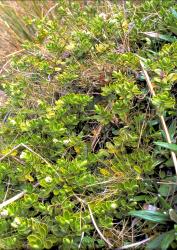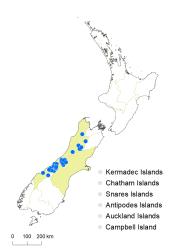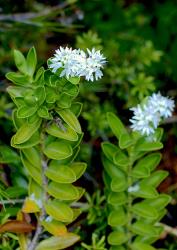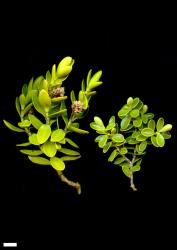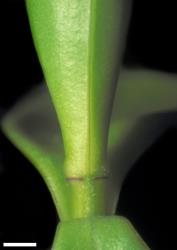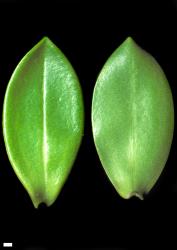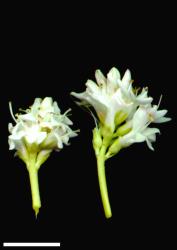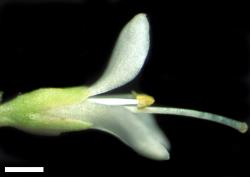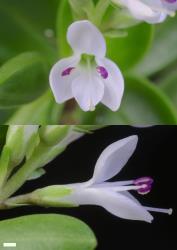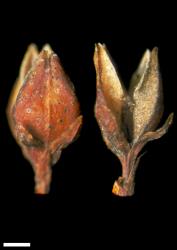- ≡ Hebe treadwellii Cockayne & Allan, Trans. & Proc. New Zealand Inst. 56: 27 (1926)
- = Hebe brockiei G.Simpson & J.S.Thomson, Trans. & Proc. Roy. Soc. New Zealand 72: 28 (1942)
Spreading low shrub to 0.3 m tall. Stems decumbent to ascending, eglandular-pubescent to almost glabrous; hairs bifarious. Leaf bud distinct, its leaves appressed at margins until fully grown; sinus absent. Leaves opposite-decussate to sub-distichous, erecto-patent; lamina sub-coriaceous to fleshy, obovate or sometimes oblanceolate or elliptic, 10–32 mm long, 4–15 mm wide, glossy, pale to dark green above, pale green beneath, midrib and sometimes two lateral veins evident; surfaces glabrous or with eglandular hairs along midrib above; margin glabrous, cartilaginous, entire; apex obtuse to rounded and minutely bluntly plicate-acuminate; base cuneate to sub-cordate; petiole absent or indistinct and broadly winged, 1–3 mm long. Inflorescence a lateral raceme, 15–31 mm long; flowers crowded, 5–34, female or bisexual on separate plants, ⚥ > ♀; bracts alternate or sometimes the lowest pair opposite, linear, lanceolate, ovate, deltoid, or oblong, ≥ pedicels; pedicels erecto-patent, 0–2.5 mm long, eglandular-hairy or some glandular hairs also, in 1 row or all around. Calyx lobes 4, rarely small 5th posterior lobe present, sub-acute to acute, rarely obtuse, 1.6–2.2 mm long, sub-equal, mixed glandular- and eglandular-ciliolate, sometimes almost glabrous. Corolla 5–8 mm diameter; tube white, 1.9–3.5 mm long, ≥ calyx, glabrous or eglandular- to glandular-hairy inside; lobes 4, white, erecto-patent to spreading, unequal, ovate to elliptic or elliptic-oblong, 3–6 mm long, obtuse or seeming sub-acute because of in-rolled margins; nectar guides absent. Stamen filaments white, 1.5–4.5 mm long; anthers pink, beige, or cream. Style glabrous, 3.5–10.5 mm long. Capsules latiseptate, acute to obtuse, glabrous, 2.5–5.0 mm long, 1.6–3.0 mm at widest point. Seeds ellipsoid to discoid, flattened, smooth, straw-yellow to pale brown, 0.9–1.5 mm long.
V. treadwellii and V. subalpina plants are very similar and sometimes grow together.
V. subalpina plants differ in their narrower and flatter leaves, without a small plicate-apiculate tip; their flowers are less crowded and have longer pedicels, and usually a shorter corolla tube, which is hairy inside. Their capsules are widest at the midpoint, unlike in V. treadwellii plants, where they are widest below the middle.
V. rakaiensis plants have similar broad and somewhat plicate-apiculate leaves, but these are minutely hairy along the margins; the ovary and base of the style are also hairy and the margins of the corolla lobes usually so. V. rakaiensis plants have corolla lobes that are generally rounder, and two of the calyx lobes are rounded, the other two acute.
South Island: Western Nelson (Bald Knob Ridge only), Canterbury (near the Main Divide), Westland.
Sub-alpine shrubland, and penalpine grassland. Recorded elevations range from 762 to 1680 m.
Flowers: December–February; fruits: December–February, persisting to October.
2n = 40 (see Bayly & Kellow 2006, as Hebe treadwellii).
Veronica treadwellii is classified in V. subg. Pseudoveronica sect. Hebe and the informal group “Occlusae” (Albach & Meudt 2010; Bayly & Kellow 2006). Analysis of ITS sequence data suggests V. treadwellii is sister species to V. subalpina.



